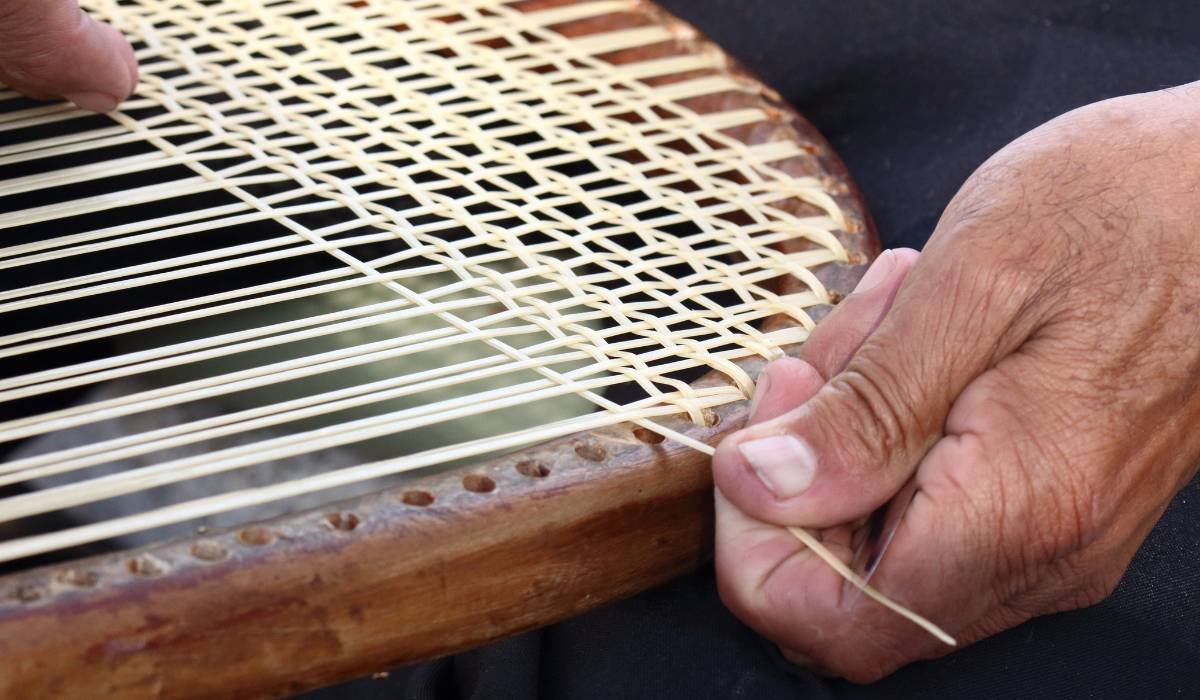Designed by the legendary Swiss-French architect and designer Pierre Jeanneret, in collaboration with his cousin and mentor, Le Corbusier, the Chandigarh chair has captivated generations of design enthusiasts with its sleek lines, innovative use of materials and unwavering commitment to ergonomics and comfort.
See also: Lounge chairs for living room
What is the Chandigarh chair?
The Chandigarh chair is a ground-breaking piece of furniture that embodies the principles of modernist design. Characterised by its distinct V-shaped silhouette, the chair features a lightweight, yet sturdy structure constructed from teak wood and cane webbing. Its genius lies in the seamless integration of form and function, where every element serves a practical purpose while contributing to the chair’s overall aesthetic appeal.
The teak wood frame provides a solid foundation and natural warmth, while the cane webbing offers breathability and gentle contouring, ensuring maximum comfort for extended periods of sitting. The chair’s minimalist design, with its clean lines and absence of ornamentation, reflects the modernist ethos of stripping away unnecessary embellishments and focusing on essential functionality.
How did the Chandigarh chair come to be?
The Chandigarh chair’s story is inextricably linked to the ambitious urban planning project of Chandigarh, India. In the 1950s, the newly independent nation embarked on the monumental task of designing and constructing a modern, planned city to serve as the capital of the state of Punjab. Le Corbusier, a pioneer of the modernist architectural movement, was commissioned to lead the project and he enlisted the help of his cousin, Pierre Jeanneret, to design furniture and interior elements for the city’s buildings.
Faced with the challenge of creating affordable and functional furniture for the government offices, schools and public spaces of Chandigarh, Jeanneret drew inspiration from traditional Indian craftsmanship and materials. The result was a series of innovative furniture designs, including the iconic Chandigarh chair.
Advantages
Beyond its timeless aesthetic appeal, the Chandigarh chair offers several practical advantages that have contributed to its enduring popularity:
Ergonomic design
The chair’s unique V-shaped frame and cane webbing provide excellent lumbar support and breathability, ensuring comfort during extended periods of sitting.
Durability
Constructed from high-quality teak wood and sturdy cane webbing, the Chandigarh chair is built to withstand the test of time, making it a long-lasting investment.
Versatility
The chair’s sleek and minimalist design allows it to seamlessly blend into a wide range of interior styles, from mid-century modern to contemporary and even traditional settings.
Sustainability
The use of natural materials, such as teak wood and cane, makes the Chandigarh chair an eco-friendly choice, aligning with modern values of sustainability and environmental consciousness.
15 modern reinventions of the classic Chandigarh chair
While the original Chandigarh chair remains a timeless classic, contemporary designers have reimagined and reinterpreted this iconic piece, infusing it with fresh perspectives and materials. Here are 15 modern reinventions that pay homage to the classic design:
The acapulco chair
A contemporary take on the Chandigarh chair, featuring a woven vinyl cord seat and back, is available in a range of vibrant colours.
The wicker Chandigarh
A natural and eco-friendly version crafted from woven wicker, creating a warm and organic aesthetic.
The metal mesh Chandigarh
A sleek and industrial interpretation featuring a mesh metal seat and back, offers a modern twist on the classic design.
The rattan Chandigarh
A tropical-inspired variation that combines the teak wood frame with a woven rattan seat and back, exuding a natural and bohemian vibe.
The leather Chandigarh
A luxurious take on the original, featuring a supple leather seat and back, adds a touch of sophistication and warmth.
The outdoor Chandigarh
A weather-resistant version crafted from marine-grade teak and durable synthetic webbing, perfect for outdoor living spaces.
The upholstered Chandigarh
A plush and comfortable interpretation featuring an upholstered seat and back, available in a variety of fabric options.
The armchair Chandigarh
A modified version with the addition of armrests, offers extra support and comfort for lounging.
The swivel Chandigarh
A modern spin on the original, featuring a swivel base for added mobility and versatility.
The colourful Chandigarh
A bold and vibrant take on the classic design, featuring a range of bright and eye-catching colours for the frame and webbing.
The minimalist Chandigarh
A pared-down interpretation that emphasises the chair’s clean lines and geometric shapes, creating a truly minimalist aesthetic.
The recycled Chandigarh
An eco-conscious version crafted from recycled materials, such as reclaimed wood and repurposed plastic, promotes sustainability and reduces waste.
The sculptural Chandigarh
A contemporary art piece that transforms the chair into a sculptural form, blurring the lines between furniture and art.
The ergonomic Chandigarh
A modern adaptation that incorporates advanced ergonomic features, such as adjustable lumbar support and customizable seating angles.
The outdoor Lounge Chandigarh
A spacious and relaxed interpretation designed for outdoor lounging, featuring a wider seat and a reclining backrest.
The Chandigarh chair stands as a testament to the enduring power of great design. Born from the visionary minds of Pierre Jeanneret and Le Corbusier, this iconic piece has transcended its humble origins to become a global symbol of modernist elegance and functional ingenuity. Through its timeless appeal and adaptability, the Chandigarh chair has been reinterpreted and reimagined by countless contemporary designers, ensuring its relevance and longevity in the ever-evolving world of interior design. Whether in its original form or through one of its many modern reinventions, the Chandigarh chair continues to captivate and inspire, reminding us of the profound impact that thoughtful design can have on our daily lives.
FAQs
What materials are used in the construction of the original Chandigarh chair?
The original Chandigarh chair is constructed from teak wood for the frame and cane webbing for the seat and back.
Is the Chandigarh chair comfortable for extended periods of sitting?
Yes, the Chandigarh chair's design prioritises ergonomics and comfort, with its contoured cane webbing providing excellent lumbar support and breathability.
Can the Chandigarh chair be used outdoors?
While the original Chandigarh chair is designed for indoor use, there are modern reinventions specifically crafted from weather-resistant materials for outdoor use.
How do I care for and maintain a Chandigarh chair?
Proper care and maintenance include regular dusting, avoiding exposure to direct sunlight and using appropriate wood and cane cleaners and conditioners.
Are there any size variations of the Chandigarh chair available?
While the original design has standard dimensions, some modern interpretations may offer different size options to accommodate varying needs and preferences.
Is the Chandigarh chair suitable for commercial or public spaces?
Absolutely. The Chandigarh chair's durability and timeless design make it an excellent choice for commercial and public settings, such as offices, hotels and restaurants.
Can the Chandigarh chair be customised or personalised?
Many contemporary furniture manufacturers offer customization options for the Chandigarh chair, allowing customers to choose their preferred materials, colours and finishes.
What is the typical price range for a high-quality Chandigarh chair?
Authentic and well-crafted Chandigarh chairs can range from several hundred to thousands of dollars, depending on the materials, craftsmanship and brand.
| Got any questions or point of view on our article? We would love to hear from you. Write to our Editor-in-Chief Jhumur Ghosh at [email protected] |

Upasana Mandhata, currently in her final year of Law, is pursuing a BA LLB Degree at VIT University Chennai. Her interest in content creation dates back to her school and college years when she discovered a writing passion. Drawing from personal experiences, her writing style has been shaped by her journey and encounters. She enjoys experimenting with new recipes, painting, or swimming while clocking out of work time.












